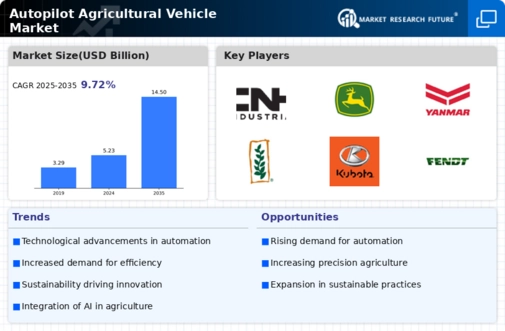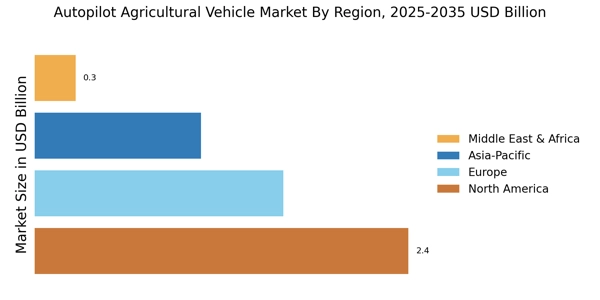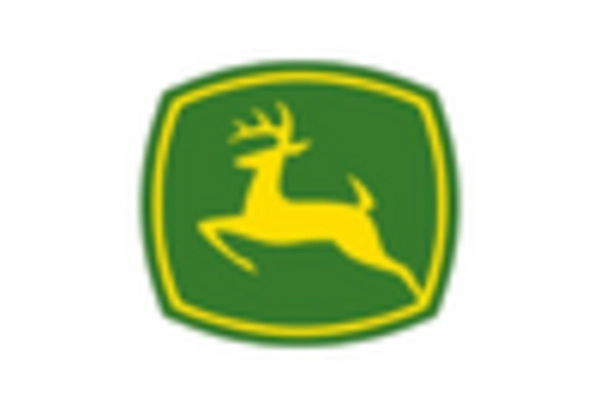Rising Labor Shortages
The Autopilot Agricultural Vehicle Market is significantly impacted by rising labor shortages in the agricultural sector. As the workforce demographic shifts and fewer individuals are willing to engage in manual labor, farmers are compelled to seek alternative solutions to maintain productivity. Autopilot vehicles present a viable answer to this challenge, allowing for continuous operation without the need for a large labor force. This trend is particularly evident in regions where agricultural labor is becoming increasingly scarce. The market is expected to expand as more farmers turn to automation to mitigate the effects of labor shortages, thereby ensuring that agricultural operations remain efficient and sustainable.
Increased Demand for Efficiency
The Autopilot Agricultural Vehicle Market is experiencing a surge in demand for efficiency among farmers and agricultural businesses. As labor costs rise and the need for higher productivity intensifies, the adoption of autopilot technology becomes increasingly appealing. This technology allows for precise operations, reducing waste and optimizing resource use. According to recent data, the implementation of autopilot systems can enhance operational efficiency by up to 30%, which is a compelling incentive for stakeholders in the agricultural sector. Furthermore, the ability to operate vehicles autonomously during off-peak hours maximizes productivity, thereby addressing the growing need for sustainable farming practices. This trend indicates a shift towards automation as a viable solution to meet the challenges faced by modern agriculture.
Regulatory Support and Incentives
The Autopilot Agricultural Vehicle Market benefits from favorable regulatory support and incentives aimed at promoting automation in agriculture. Governments are increasingly recognizing the potential of autonomous vehicles to enhance food production and ensure food security. Various initiatives, such as grants and subsidies for adopting advanced agricultural technologies, are being implemented to encourage farmers to invest in autopilot systems. This regulatory environment not only facilitates market entry for new technologies but also fosters innovation within the industry. As a result, the market is likely to see a rise in the adoption of autopilot vehicles, driven by both economic and regulatory factors that support sustainable agricultural practices.
Growing Focus on Precision Agriculture
The Autopilot Agricultural Vehicle Market is closely linked to the growing focus on precision agriculture. This approach emphasizes the use of technology to monitor and manage field variability in crops, leading to improved yields and reduced environmental impact. Autopilot vehicles equipped with advanced sensors and data analytics capabilities enable farmers to apply inputs more accurately, thereby minimizing waste and enhancing sustainability. The market for precision agriculture is projected to reach substantial figures in the coming years, with autopilot vehicles playing a crucial role in this transformation. As farmers increasingly adopt precision techniques, the demand for autopilot agricultural vehicles is likely to rise, further driving market growth.
Technological Integration and Innovation
The Autopilot Agricultural Vehicle Market is significantly influenced by ongoing technological integration and innovation. The advent of advanced sensors, GPS technology, and machine learning algorithms has revolutionized the way agricultural vehicles operate. These innovations enable real-time data collection and analysis, allowing for more informed decision-making. For instance, the integration of AI-driven systems can lead to improved crop management and yield predictions. As a result, the market is projected to grow at a compound annual growth rate of approximately 15% over the next five years. This growth is indicative of the increasing reliance on technology to enhance agricultural productivity and sustainability, making it a critical driver in the autopilot vehicle sector.


















Leave a Comment